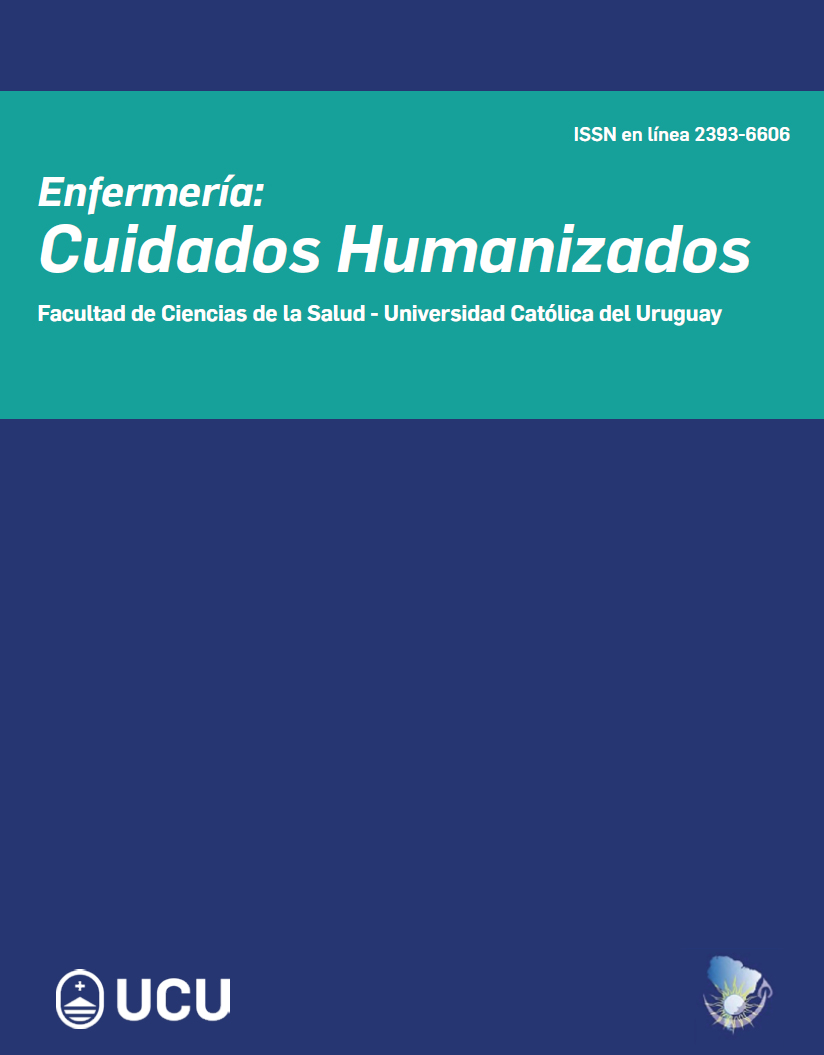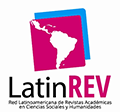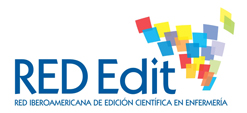Evidence for the Treatment of Wounds in Newborns: An Integrative Review
DOI:
https://doi.org/10.22235/ech.v13i1.3220Keywords:
newborns, wounds, dressings, nursing careAbstract
Introduction: Given the particularities and challenges in the management and treatment of wounds in newborns, it becomes important for nurses to know, indicate and evaluate the efficacy and safety of dressings and products, even in the analysis of products for the neonatal population. Objective: To identify in the literature the main dressings and products used to treat wounds in newborns. Methodology: This is an integrative literature review, with articles published between 2018 and 2022, which addressed the topics of dressings and products used in the treatment of wounds in newborns. Data collection was carried out through consultation in Biblioteca Virtual de Saúde and in the Scientific Electronic Library Online. The “newborn”, “wounds” and “bandage” descriptors were used. The analysis was carried out according to the PICO strategy and structured following PRISMA. Results: Given the findings, it was possible to identify 13 articles that addressed products and dressings intended for treating wounds in newborns. Fourteen types of dressings/products and devices that use negative pressure therapy were found. Final considerations: The literature indicates the use of products and dressings with passive, active and biological principles for the treatment of wounds in newborns, including premature neonates, and it is worth highlighting the importance of considering the safe use of dressings that are suitable for this population.
Downloads
References
Albahrani Y, Hunt R. Newborn Skin Care. Pediatric annals. 2019 [acesso em 2023 fev 07];48(1):e11–e15. doi: 10.3928/19382359-20181211-01
Grosvenor J, Dowling M. Prevention of neonatal pressure injuries. J Neonatal Nurs. 2018 [acesso em 2023 jul 07]; 24(3);122-125. doi: 10.1016/j.jnn.2017.09.004
Johnson E, Hunt R. Infant skin care: updates and recommendations. Curr Opin Pediatr. 2019 [acesso em 2023 fev 7];31(4):476-481. doi: 10.1590/S0080-62342011000100018
Faria TF, Kamada I. Lesões de pele em neonatos em cuidados intensivos neonatais. Enfermería Global. 2017 [acesso em 2020 fev 2];17(1):220-228. doi: 10.6018/eglobal.17.1.273671
Amer Y, Bridges C, Marathe K. Epidemiology, Pathophysiology, and Management Strategies of Neonatal Wound Care. Neoreviews [acesso em 2023 ago 07];22(7):e452-e460. doi: 10.1542/neo.22-7-e452
Parizad N, Hajimohammadi K, Hassanpour A, Goli R. Treating surgical site infection by honey antibacterial wound dressing in a neonate: a case report. British Journal of Nursing. 2022 [acesso em 2023 ago 07];31(4). doi: 10.12968/bjon.2022.31.4.S8
Rezaei PMS, Jafari-Mianaei S, Sadeghnia A, Heidari Z. Protective Dressings, Injury, and Device Failure in Preterm Infants Receiving Nasal Continuous Positive Airway Pressure: A Randomized Controlled Trial. Advances in Skin & Wound Care. 2023 [acesso em 2023 fev 07];34(9):1-6. doi: 10.1097/01.ASW.0000767344.37591.b6
Soares CB, Hoga LAK, Peduzzi M, Sangaleti C, Yonekura T, Silva DRAD. Integrative review: concepts and methods used in nursing. Rev Esc Enferm USP. 2014 [acesso em 2023 jul 08];48(2):335-345. doi: 10.1590/S0080-623420140000200020
Eriksen MB, Frandsen TF. The impact of patient, intervention, comparison, outcome (PICO) as a search strategy tool on literature search quality: a systematic review. Journal of The Medical Library Association. 2018;106(4):420-431. doi: 10.5195/jmla.2018.345
Page MJ, McKenzie JE, Bossuyt PM, Boutron I, Hoffmann TC, Mulrow CD, et al. The PRISMA 2020 statement: an updated guideline for reporting systematic reviews. BMJ. 2021 [acesso em 2020 feb 07];372(71). doi: 10.1136/bmj.n71
Fan K, Tang J, Escandon J, Kirsner RS. State of the art in topical woundhealing products. Plast Reconstr Surg. 2011 [acesso em 2020 fev 07]127(Suppl.1):44S-59S. doi: 10.1097/PRS.0b013e3181fbe275
Parizad N, Hajimohammadi K, Hassanpour A, Goli R. Treating surgical site infection by honey antibacterial wound dressing in a neonate: a case report. Br J Nurs. 2022 [acesso em 2023 set 10];31(4). doi: 10.12968/bjon.2022.31.4.S8
Martínez G, D' Ángelo J. Uso de VAC en neonatos. Rev. argent. cir. Plást. 2021 [acesso em 2023 set 01];27(2):86-89. doi: 10.32825/RACP/202102/0086-0089
Boyar V. Association of Systemic or Intravitreal Antivascular Endothelial Growth Factor (Anti-VEGF) and Impaired Wound Healing in Pediatric Patients: Collagen to the Rescue. Journal of Wound, Ostomy and Continence Nursing. 2021 [acesso em 2023 set 01];48(3):256-261. doi: 10.1097/WON.0000000000000764
Harma B, Gül M, Demircan M. The Efficacy of Five Different Wound Dressings on Some Histological Parameters in Children with Partial Thickness Burns. Journal of Burn Care & Research. 2020 [acesso em 2023 set 01];41(6):1179–1187. doi: 10.1093/jbcr/iraa063
Sherman G, Shulman-Manor O, Dagan O, Livni G, Scheuerman O, Amir G, et al. Vacuum-Assisted Closure for the Treatment of Deep Sternal Wound Infection After Pediatric Cardiac Surgery. Pediatric Critical Care Medicine. 2020 [acesso em 2023 set 01];21(2):150-155. doi: 10.1097/PCC.0000000000002131
Ivanzov S, Soynov I, Kulyabin Y, Zubritskiy A, Voitov A, Omelchenko A, et al. Vacuum-assisted closure versus closed irrigation for deep sternal wound infection treatment in infants: a propensity score-matched study. Interactive CardioVascular and Thoracic Surgery. 2019 [acesso em 2023 set 01];29(5):776–782. doi: 10.1093/icvts/ivz167
Padalino MA, Carrozzini M, Vida V, Stellin G. Vacuum-Assisted Closure Therapy for the Treatment of Poststernotomy Wound Dehiscence in Neonates and Infants. Thorac Cardiovasc Surg. 2019 [acesso em 2023 set 01];67:055-057. doi: 10.1055/s-0037-1603933
Pereima MJL, Feijó R, Oenning da Gama F, de Oliveira Boccardi R. Treatment of burned children using dermal regeneration template with or without negative pressure. Burns. 2019 [acesso em 2023 set 02];45(5):1075-1080. doi: 10.1016/j.burns.2018.08.009.
Zoeller C, Yoshizawa E, Sethi MV, Ure BM, Kuebler JF. Negative Pressure Wound Dressing Reduces Surgical Site Infections in Infants after Closed Abdominal Procedures: A Preliminary Report. Eur J Pediatr Surg. 2019 [acesso em 2023 set 02];29(4):384-387. doi: 10.1055/s-0038-16604482019.
Bayci A, Akay B. Advanced Techniques in the Use of Negative Pressure Wound Therapy for Closure of Complex Neonatal Abdominal Wounds. Journal of Wound, Ostomy and Continence Nursing. 2018 [acesso em 2023 set 10];45(5):468-471. doi: 10.1097/WON.0000000000000471
Copeland H, Newcombe J, Yamin F, Bhajri K, Ayer Mille V, Hasaniya N, et al. Role of Negative Pressure Wound Care and Hyperbaric Oxygen Therapy for Sternal Wound Infections After Pediatric Cardiac Surgery. World Journal for Pediatric and Congenital Heart Surgery. 2018 [acesso em 2023 set 12];9(4):440-445. doi: 10.1177/2150135118772494
Boyar V. Treatment of Dehisced, Thoracic Neonatal Wounds With Single-Use Negative Pressure Wound Therapy Device and Medical-Grade Honey: A Retrospective Case Series. Journal of Wound, Ostomy and Continence Nursing. 2018 [acesso em 2023 set 12];45(2):117-122. doi: 10.1097/WON.0000000000000407
Fras Zemljič L, Maver U, Kraševac Glaser T, Bren U, Knez Hrnčič M, Petek G, et al. Electrospun Composite Nanofibrous Materials Based on (Poly)-Phenol-Polysaccharide Formulations for Potential Wound Treatment. Materials (Basel). 2020 [acesso em 2023 set 12];13(11):2631. doi: 10.3390/ma13112631
Jesus LE, Martins AB, Oliveira PB, Gomes F, Leve T, Dekermacher S. Negative pressure wound therapy in pediatric surgery: How and when to use. Journal of Pediatric Surgery. 2018 [acesso em 2023 set 12];53(4):585-591. doi: 10.1016/j.jpedsurg.2017.11.048
Abdelgawad MA, Parambi DGT, Ghoneim MM, Alotaibi NH, Alzarea AI, Alanazi AS, et al. A meta-analysis showing the effect of surgical site wound infections and associated risk factors in neonatal surgeries. Int Wound J. 2022 [acesso em 2023 set 12]; 19(8):2092-2100. doi: 10.1111/iwj.13814
Qiao Y, Zhang T, Bai T, Peng X, Lin H, Zhang A. Effect of body mass index on surgical site wound infection, mortality, and postoperative hospital stay in subjects undergoing possibly curative surgery for colorectal cancer: A meta-analysis. Int Wound J. 2023 [acesso em 2023 set 12];20(1):164-172. doi:10.1111/iwj.13860
Secco IL, Danski MTR, Pereira HP, Almeida TQR de, Cruz TR. Cuidados de enfermagem a recém-nascido com infecção de sítio cirúrgico incisional profunda: relato de caso. Rev esc enferm USP [Internet]. 2021 [acesso em 2023 set 12];55:e03769. doi: 10.1590/S1980-220X2020047203769
Santos SV, Ramos FR, Costa R, Batalha LM. Assessment of the quality of a software application for the prevention of skin lesions in newborns. Rev Latino-Am Enfermagem. 2020 [acesso em 2023 set 12];28:e3352. doi: 10.1590/1518-8345.3711.3352
Catania VD, Boscarelli A, Lauriti G, Morini F, Zani A. Risk factors for surgical site infection in neonates: a systematic review of the literature and meta-analysis. Front Pediatr. 2019 [acesso em 2023 set 12];7(101). doi: 10.3389/fped.2019.00101
Ferraz LCC, Guedes BLS, Lucio IML, Santos RCS. Desenvolvimento de protetor nasal anatômico para recém-nascidos em uso de pronga. Rev. esc. enferm. USP [online]. 2020 [acesso em 2023 set 12];54:03618. doi: 10.1590/s1980-220x2019005603618.
Published
How to Cite
Issue
Section
License
Copyright (c) 2024 Enfermería: Cuidados Humanizados

This work is licensed under a Creative Commons Attribution 4.0 International License.

















